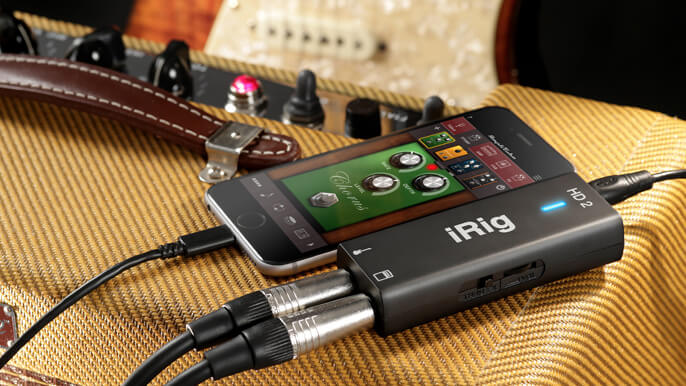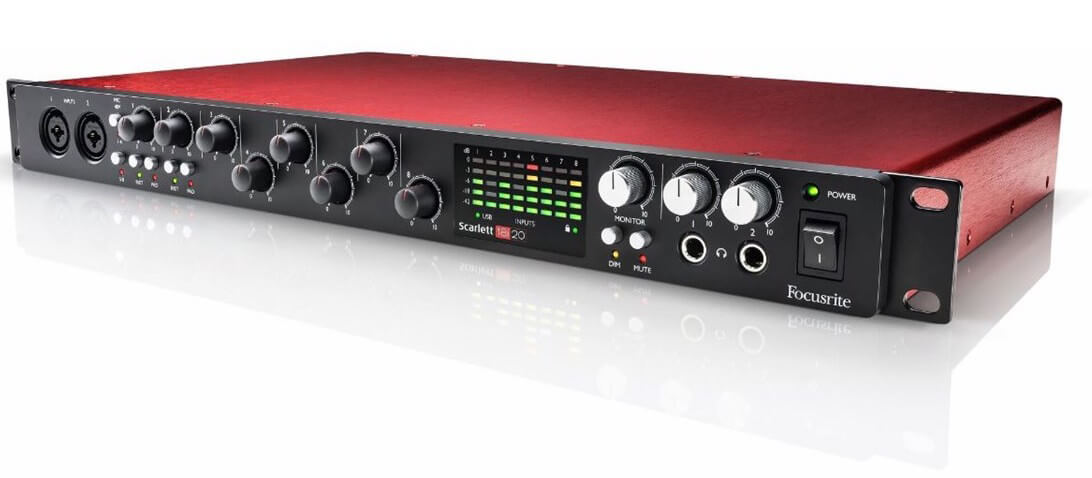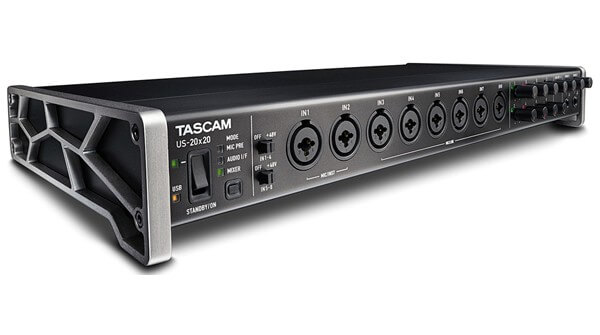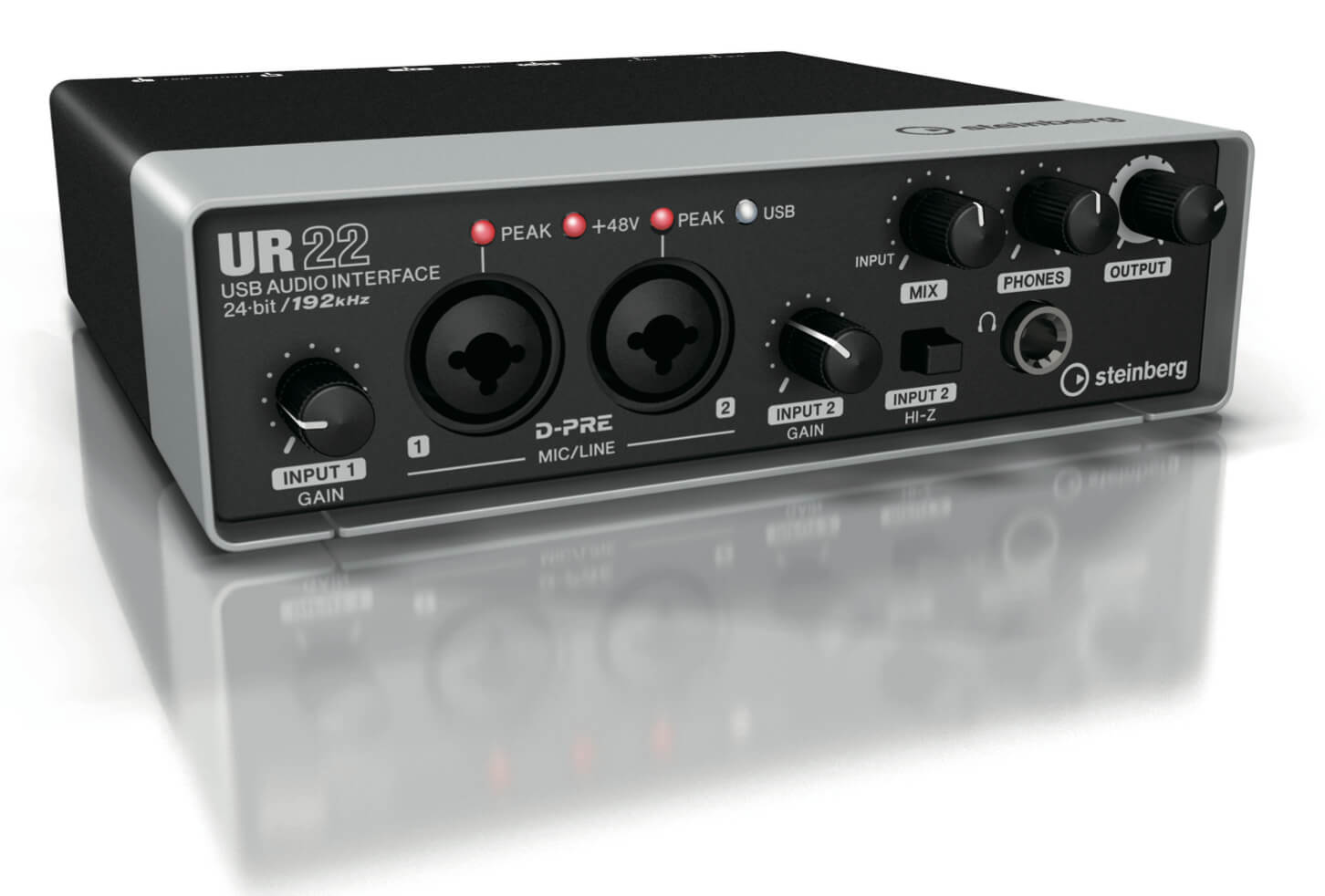What are the best audio interfaces (and mic preamps) for Mac and PC? Performer takes a look at some of our most recent favorites under $1000 in our ‘Audio Interface Buyer’s Guide.’
iRig HD 2 Guitar Interface
IK Multimedia’s iRig HD 2 guitar interface is a great way to turn a smartphone or tablet into a fantastic practice and recording tool. Taking things to the next level, the iRig HD 2 brings more features that are great in both recording and live situations.

iRig HD 2
The small soft rubber enclosure has 1/4” TRS inputs for guitar or bass, 1/4” out to an amp, a 1/8” headphone jack, and a USB connection. There are Apple & Android cables, as well as USB cable for every possible connection. With the iRig HD 2 comes IK’s AmpliTube amp modeling app and software not only for the mobile device, but for Mac or Windows.
There are a few ways to use this neat little device. Connect the iRig to a smartphone/tablet, plug in headphones, plug in a guitar, and open up the AmpliTube app. Band- you’ve got a great rig simulation for practice, rehearsals or personal playing. It also works well with GarageBand and other similar apps. There is a switch on the side marked Thru FX, and by connecting the iRig HD 2 to a guitar amp, or PA, all those great AmpliTube tones can now get routed to the amp. Switching the Thru FX switch to the other position, it can now be used as an inline tuner…
PRICE: $99
Focusrite Second-Generation Scarlett Interfaces
There are a lot of options when it comes to audio interfaces for your DAW, both in features and in price. Focusrite recently launched their next-gen Scarlett line, and we got our hands on the 2-in, 2-out Focusrite Scarlett 2i2 model as well as the more robust Focusrite Scarlett 18i20. In short, each brings a lot of bang for the buck, without overwhelming the user. We appreciated the simplicity with which one could get up and running, a hurdle that we’ve had to jump over in other similarly priced interfaces in the past.
The 18i20 is the top tier of the Scarlett range, with (8) TRS/XLR inputs. Phantom power is available, but can be switched on or off in groups; 1-4 and 5-8. Channels 1 & 2 are on the front panel, and have selections for line or instrument levels, as well as the ability to engage a 10dB pad for things like super-hot guitars. Speaking of which, the new instrument inputs handle hotter pickups much better than the previous generation (and FAR better than something like the Steinberg UR22 we tested earlier this year). The individual gain controls and Digital VU meter also reside on the front panel. Monitor and headphone control and outputs also reside here, handy when you can’t reach around back in a darkened control room…
PRICE: $149 (2i2) and $499 (18i20), respectively
PreSonus Studio 192 and DigiMax DP88
Think of the Studio 192 as the brains of the operation. It connects to the computer via USB 3.0, with mic/instrument combo inputs on the front, and 6 mic/line combo inputs on the back. For headphone or monitoring outputs, the outs on the front are for headphones, while the eight on the rear are lines outs. You also get two dedicated rear-panel main left/right outputs with level control, muting, and mono summing for control room monitoring. This gives the ability to really control the monitoring for individual musicians during a session, where the drummer doesn’t want to hear the guitars, or just the bass, while the guitarist doesn’t want to hear the bass at all, for example. A built in Talkback mic makes for easy communication during a session without any external gear! In all, it makes for a comfortable listening session for everyone involved. Inside the Studio 192 is a DSP processor that allows relief from the DAW, handling a share of the monitoring, as well as its processing, which in return, helps eliminating latency during tracking…

PRICE: $899 (Studio 192) and $699 (DigiMax DP88)
TASCAM US-20×20 USB Audio Interface
The new US-20×20 features 8 XLR/TRS combo inputs (and excellent preamps) on the front, along with level controls and two headphone outs with level controls. The rear panel handles coaxial, SPDIF, USB 3.0, MIDI, 1/4” line-ins and line outs. It works with Windows and Mac systems, and with a variety of DAWs such as Logic, Sonar, Pro Tools and Studio One. It can also work as a standalone mixer for live use, as well. With its own software suite boasting EQ, Compressors, Reverb, and Compression options, the new TASCAM unit easily transitions from a studio interface to a digital mixer with all the bells and whistles you could need. The unit works effectively as a digital patch bay, with the excellent input and output options. The software is easy to navigate, and even a novice should be able to unlock advanced options easily.
The mic preamps are nice and clear, which considering TASCAM’s background, isn’t surprising. And with a great selection of ins and outs, there are no limitations or special adapters needed to get things going. It’s an excellent way for a band to expand from a starter home recording setup, to a full blown recording rig very easily (with a fairly small footprint, to boot). When not being used in the recording world, flip a switch on the front and it can act as a mixer for practice and live applications. One more flip of the switch and you’re now using it solely as a mic preamp…
PRICE: $499
Steinberg UR22 USB Audio Interface
Tracking with the Steinberg UR22 is a snap and since it’s a 24-bit/192kHz interface, audio quality (assuming your rig can handle it) is pretty darn great for a unit so affordable. We popped it in front of simple DAW programs like GarageBand, as well as more pro-studio setups like Cubase and Mixcraft 7. Setup was simple: plug it into your USB port after installing the drivers (no additional power cable necessary) and then choose which input you want to arm your track with. We really dug the Hi-Z option on Input 2 (don’t forget to engage it on the front panel) for easy tracking of direct, dry guitar and bass signals (we then let our imaginations run wild after we captured raw tracks, by running through a ton of amp simulators and fx).
Controls are simple and intuitive, and for project studios running a few mics, a direct line for guitars/basses, and maybe a MIDI controller for soft synths, it’s a perfect solution. But what we dug more was its ability to be a real road warrior. The rugged, all-metal enclosure means you can toss it in a backpack and take it out on tour. And since it’s powered by USB, all you need is a battery-powered laptop or tablet and you’ve got a mobile recording/practice studio right in your tour van. Perfect for on-the-go demos and scratch tracks, and we didn’t encounter any notable latency (which can an issue for units in this price range)…




